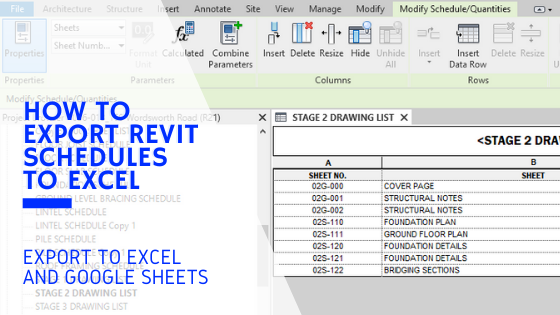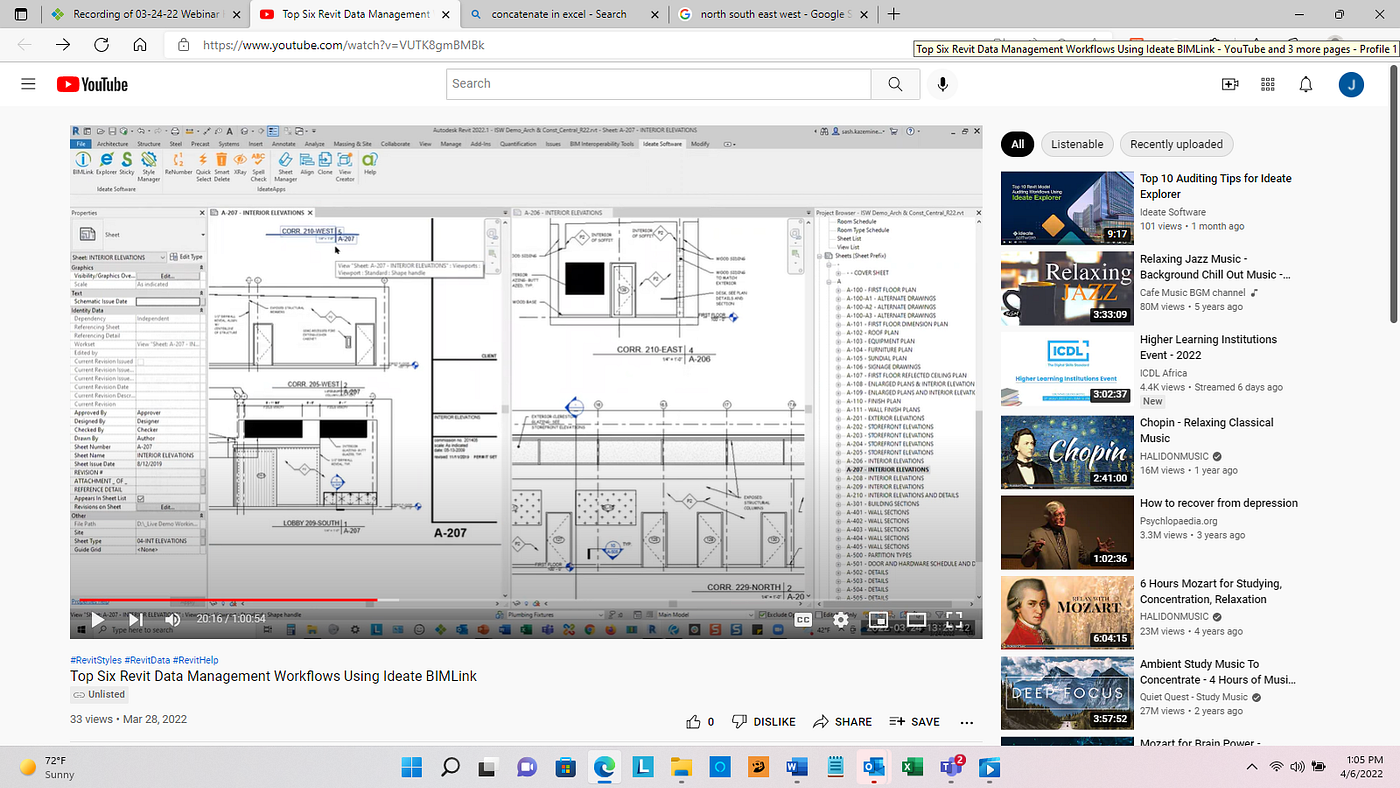Import Excel into Revit: Improving Your Process
Wiki Article
Excel-to-Revit: A Game-Changing Workflow for Architectural Design - Revealing the Tricks
Presenting excel-to-revit, the game-changing process that will transform your design procedure. With excel-to-revit assimilation, you can enhance your architectural design, unlock efficiency, and make the most of collaboration within your group. Get ready to take your building style to the next level with excel-to-revit!The Power of Excel-to-Revit Assimilation

Think of the convenience of having the ability to update and modify project information in Excel, and quickly see those changes shown in your Revit version. No a lot more manual information entry or tiresome updates. With Excel-to-Revit integration, you can save time and reduce errors by leveraging the power of Excel's features and formulas to immediately generate precise information in Revit.
Not only does this assimilation improve effectiveness, yet it also boosts collaboration among employee. You can quickly share Excel documents with colleagues, who can after that import the data into their Revit versions. This advertises a seamless exchange of info and makes certain that everyone is collaborating with one of the most up-to-date data.

Simplifying Architectural Style With Excel-To-Revit
Simplifying architectural style is simplified with using Excel-to-Revit (import excel into revit). With this effective assimilation, you can optimize your process and conserve useful time throughout the style process. By leveraging the capacities of Excel and Revit, you can seamlessly move information in between the 2 platforms, removing the requirement for hands-on data access and decreasing the danger of mistakesExcel-to-Revit permits you to import and export data effortlessly, enabling you to quickly update and change your building layouts. You can create schedules, determine quantities, and produce records in Excel, and after that move that information straight right into your Revit model. This integration guarantees that your style details is constantly current and integrated, removing the demand for hand-operated updates and lowering the chances of inconsistencies.
By using Excel-to-Revit, you can also take advantage of the powerful computational capabilities of Excel. You can perform complex calculations, analyze data, and automate repetitive jobs, all within Excel. After that, with simply a couple of clicks, you can import the results back into Revit, allowing you to make informed layout choices and enhance your architectural designs.
Opening Effectiveness: Checking Out the Excel-to-Revit Workflow
Optimize your performance by perfectly integrating Excel and Revit for a more reliable process. With the Excel-to-Revit workflow, you can open a whole new degree of effectiveness in your architectural layout process. By utilizing the power of Excel's information administration capacities and integrating it with the versatility and accuracy of Revit, you can enhance your style procedure and conserve valuable time.Among the essential advantages of this combination is the ability to import and export information between Excel and Revit. This suggests that you can quickly move job information, such as area schedules or product quantities, from one software program to the other, removing the requirement for hand-operated data access and minimizing the chances of errors. You can additionally create personalized formulas and estimations in Excel to automate repetitive jobs and perform complicated estimations, which can then be flawlessly integrated right into your Revit models.
Moreover, the Excel-to-Revit operations enables far better control and collaboration in between group members. With Excel functioning as a main data hub, several employee can deal with different facets of the task simultaneously, sharing and upgrading information in real-time. This not only enhances interaction yet also guarantees that everybody is dealing with one of the most up-to-date data, eliminating the danger of variances.
Maximizing Collaboration: Excel-to-Revit for Architectural Teams
By perfectly incorporating Excel and Revit, building groups can substantially boost collaboration and achieve more efficient design outcomes. When using this powerful workflow, you can easily transfer data in between Excel spread sheets and Revit models, enhancing the style process and enhancing interaction among staff member. With Excel-to-Revit assimilation, you can easily import task information, such as space routines, material quantities, and project parameters, straight right into Revit, getting rid of the requirement for manual data access and reducing the chances of mistakes. This smooth connection allows for real-time updates, guaranteeing that everyone is collaborating with one of the most updated information and avoiding disparities in between different documents.In addition, by leveraging Excel's powerful computation abilities, you can do intricate estimations and evaluation on your design information, offering beneficial insights and driving educated decision-making. This integration likewise enables you to export data from Revit to Excel, allowing you to produce thorough reports, graphes, and charts for presentations and evaluation. This collaborative process promotes efficient interaction and coordination amongst employee, as Excel functions as a central hub for information monitoring and sharing.
Overall, by accepting the Excel-to-Revit workflow, architectural groups can attain higher levels of cooperation, efficiency, and accuracy in their style process. revit tools. This assimilation empowers teams to work with each other flawlessly, guaranteeing that everybody gets on the very same page and adding to the success of the job
Unveiling the Keys of Excel-to-Revit Integration

One of the secrets of Excel-to-Revit combination is the capability to take advantage of the power of solutions and computations in Excel to drive criteria and create complex geometries in Revit. You can link Excel spreadsheets to Revit families, allowing you to input data directly into the spreadsheet and have it automatically upgrade in the Revit version. This streamlines the design procedure and ensures precision and uniformity throughout the project.
Another key is the capacity to develop personalized timetables and records in Excel, utilizing information drawn out from Revit. This allows you to visualize and analyze task details in a manner that is not possible within Revit alone. You can easily produce quantity take-offs, cost price quotes, and job timelines, supplying important insights for decision-making and task monitoring.
In addition, Excel-to-Revit integration enables reliable partnership among staff member. Several users can work with the very same Excel spreadsheet simultaneously, making it less complicated to work with and track modifications. You can also make use of Excel's commenting function to provide comments or connect style alterations.
Final Thought
By combining the power of Excel and Revit, architects can currently function much more efficiently, conserve time, and create much better designs. Beginning incorporating excel-to-revit combination into your architectural layout procedure today and transform the method you function.With simply a couple of clicks, you can import the results back right into Revit, permitting you to make educated design choices and enhance your building styles.
By utilizing the power of Excel's information administration capabilities and incorporating it with the versatility and precision of Revit, you can enhance your design procedure and save valuable time.
By flawlessly integrating Excel and Revit, building teams can greatly enhance collaboration and attain much more reliable design end results. When using this effective workflow, you can conveniently transfer information in between revit plugins Excel spreadsheets and Revit versions, improving the layout process and boosting communication among group members.Moreover, by leveraging Excel's powerful computation capacities, you can carry out complicated calculations and analysis on your layout data, driving and supplying valuable insights notified decision-making.
Report this wiki page